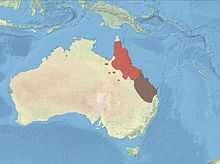Black-throated Finch
- The name Black-throated Finch may also refer to the Canary-winged Finch (Melanodera melanodera) of South America.
| Black-throated Finch | |
|---|---|
 | |
| At Baltimore Aquarium, Maryland, USA | |
| Conservation status | |
| Scientific classification | |
| Kingdom: | Animalia |
| Phylum: | Chordata |
| Class: | Aves |
| Order: | Passeriformes |
| Family: | Estrildidae |
| Genus: | Poephila |
| Species: | P. cincta |
| Binomial name | |
| Poephila cincta (Gould, 1837) | |
 | |
| The Distribution of the Black-throated Finch | |
The Black-throated Finch (Poephila cincta), or Parson Finch, is a species of estrildid finch found in grassy woodlands throughout north-east Australia from Cape York Peninsula to north-east New South Wales. It is declining and its habitat is threatened by development.
Taxonomy
Originally described by ornithologist John Gould in 1837, its specific epithet is Latin cincta "girdled".[2] It is placed in the Australo-papuan Finch family Estrildidae, although this family itself was previously placed in the sparrow family Passeridae.[3]
A genetic study published in 2005 showed it diverged from the Long-tailed Finch (P. acuticauda) 0.6 million years ago.[4]
Parson Finch is an alternate common name.[5]
Subspecies
The Black-throated Finch has two subspecies, with intermediate forms found between the two.
- Poephila cincta cincta is a white-rumped form found south of Townsville[6]
- Poephila cincta atropygialis is a black-rumped form found north of Cairns, and is possibly extending its range southwards.[6]
Description
Measuring around 10 cm (4 in) in length, the Black-throated Finch has a short black bill, lores, and throat, sharply delineated from the rest of the pale grey head. The wings, breast and belly are pale pinkish brown, and the short tail is black, while the rump is black in northern forms and white in southern.[7]
Distribution and habitat
The Black-throated Finch was traditionally found from Cape York south through eastern Queensland and into northeastern New South Wales in the vicinity of Tenterfield, however has not been recorded in New South Wales since 1994. It is sedentary or locally nomadic. It is found in grassy open forested habitats,[7] generally near bodies of water such as rivers.
Threats
For the past few decades, the population of this species has declined; the southern subspecies has been declared threatened in New South Wales,[8] and vulnerable in Queensland, and appears to have vanished from 80% of its former range.[9] The reason for the declined population is probably due to spread of pastoralism, changes in fire regime and increases in the density of native woody weeds in grassy savannas. A national Management Plan was published in 2004 by the NSW and Qld Governments.[10]
Much of the remaining population is located near Townsville, and there have been issues with development encroaching on suitable habitat.[11]
Behaviour
The Black-throated Finch is found in flocks of up to 30 birds.[6]
Feeding
The Black-throated Finch primarily eats seed from various species of grass, and also eats spiders and ants. In the wet season, birds also hunt flying termites.
Breeding
Breeding may occur from September to January in the southern parts of its range, and after the monsoon season in February onwards in the north. One or two broods are laid during this time. The nest is a round structure woven from dried grasses with tube-like entrance placed high in a eucalypt 5 metres above the ground. Four to six matte white oval eggs are laid, measuring 12 x 17 mm.[12]
Aviculture
The species breeds and survives readily in captivity.[13]
Origin
Origin and phylogeny has been obtained by Antonio Arnaiz-Villena et al.[14] Estrildinae may have originated in India and dispersed thereafter (towards Africa and Pacific Ocean habitats).
References
- ↑ BirdLife International (2012). "Poephila cincta". IUCN Red List of Threatened Species. Version 2013.2. International Union for Conservation of Nature. Retrieved 26 November 2013.
- ↑ Simpson DP (1979). Cassell's Latin Dictionary (5 ed.). London: Cassell Ltd. p. 883. ISBN 0-304-52257-0.
- ↑ Christidis L, Boles WE (2008). Systematics and Taxonomy of Australian Birds. Canberra: CSIRO Publishing. p. 177. ISBN 978-0-643-06511-6.
- ↑ Jennings, W. Bryan, WB; Edwards, Scott V. (2005). "Speciational history of Australian grass finches ( Poephila ) inferred from 30 gene trees". Evolution 59 (9): 2033–47. PMID 16261740. Retrieved 29 January 2011.
- ↑ Wade P. (ed.) (1977). Every Australian Bird Illustrated. Rigby. p. 277. ISBN 0-7270-0009-8.
- ↑ 6.0 6.1 6.2 Zann R (1976). "Distribution, status and breeding of Black-throated Finches Poephila cincta in Northern Queensland". Emu 76 (4): 201–06. doi:10.1071/MU9760201. Retrieved 2008-10-31.
- ↑ 7.0 7.1 Slater, Peter (1974). A Field Guide to Australian Birds:Non-passerines. Adelaide: Rigby. p. 261. ISBN 0-85179-813-6.
- ↑ "Threatened Species:Black-throated Finch (southern subspecies) - profile". Department of Environment and Climate Change website. New South Wales Government, Department of Environment and Climate Change. 2005-09-01. Retrieved 2008-10-31.
- ↑ "Threatened Species:Black-throated finch (southern subspecies)". Environmental Protection Agency website. The State of Queensland (Environmental Protection Agency). 2007-08-31. Retrieved 2008-10-31.
- ↑ "National recovery plan for the Black-throated finch southern subspecies (Poephila cincta cincta)". Department of the Environment, Water, Heritage and the Arts - website. Australian Government: Department of the Environment, Water, Heritage and the Arts. 2007-02-09. Retrieved 2008-11-01.
- ↑ "Endangered bird keeps family in shed". Nine News MSN website. Nine MSN. 2008-10-20. Retrieved 2008-11-01.
- ↑ Beruldsen, G (2003). Australian Birds: Their Nests and Eggs. Kenmore Hills, Qld: self. p. 405. ISBN 0-646-42798-9.
- ↑ Kingston, R. J. 1998, Keeping and Breeding Finches and Seed-eaters, Indruss Publications, New Farm.
- ↑ Arnaiz-Villena, A; Ruiz-del-Valle V, Gomez-Prieto P, Reguera R, Parga-Lozano C, Serrano-Vela I (2009). "Estrildinae Finches (Aves, Passeriformes) from Africa, South Asia and Australia: a Molecular Phylogeographic Study". The Open Ornithology Journal 2: 29–36. doi:10.2174/1874453200902010029.
External links
| Wikimedia Commons has media related to Poephila cincta. |
